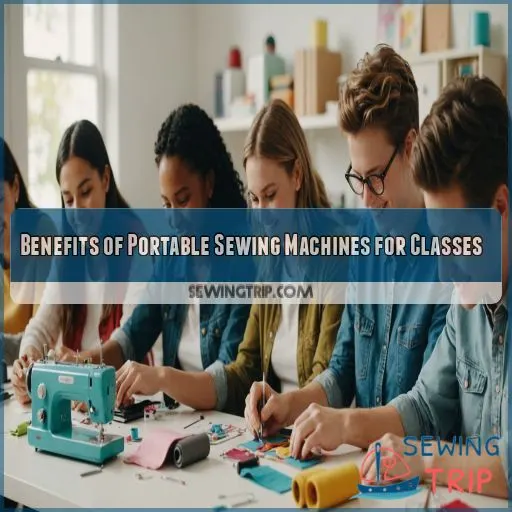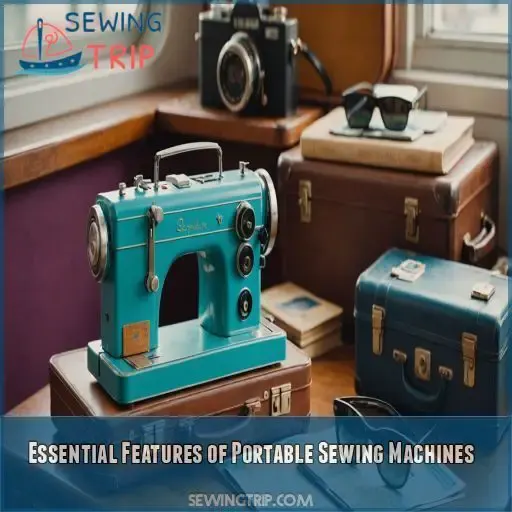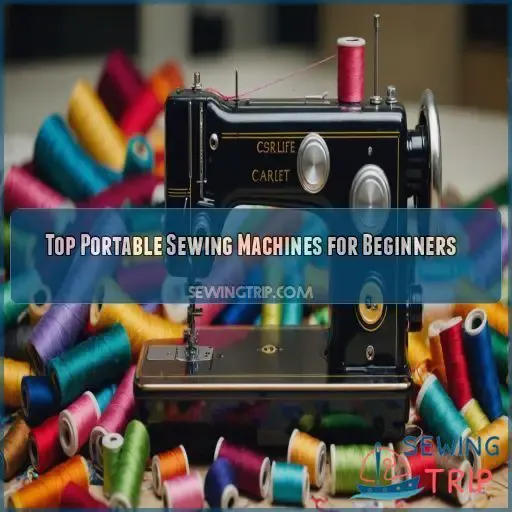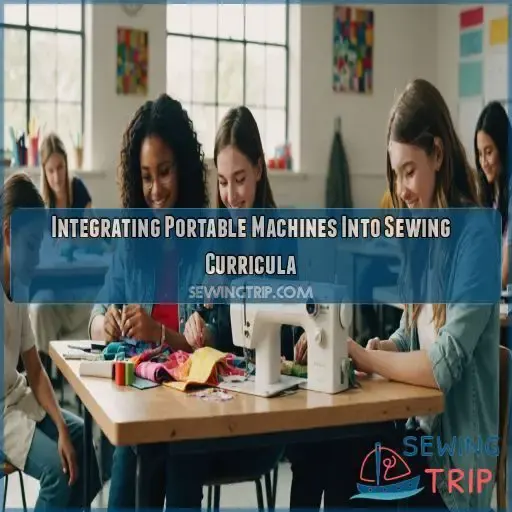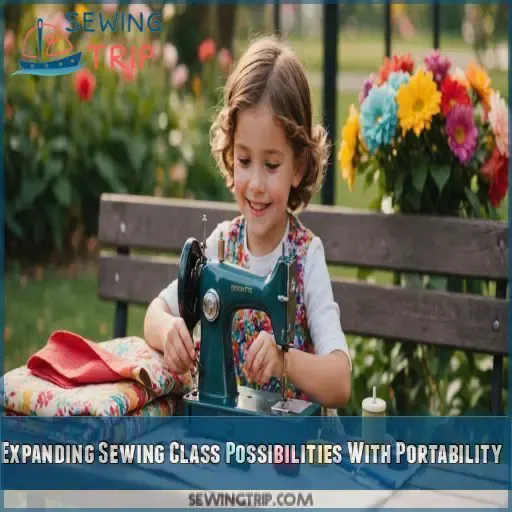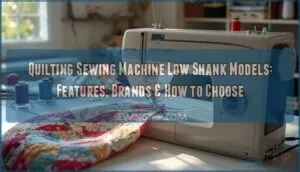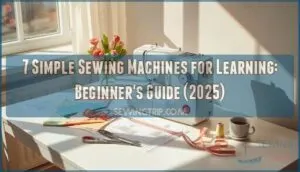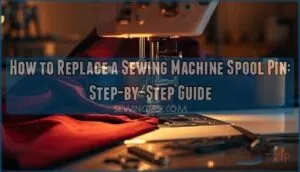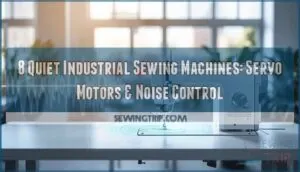This site is supported by our readers. We may earn a commission, at no cost to you, if you purchase through links.
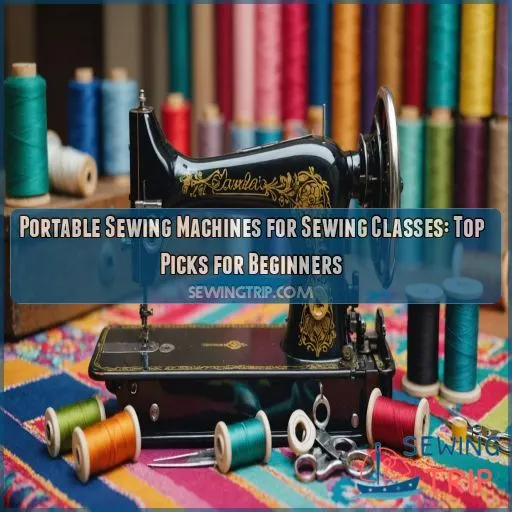 You’re about to open up a world of creativity and freedom in your sewing classes with portable sewing machines!
You’re about to open up a world of creativity and freedom in your sewing classes with portable sewing machines!
Imagine teaching anywhere, anytime, without being tied to a traditional classroom.
With portable machines, you can easily transport your teaching tools, free up valuable space in small classrooms, and offer cost-effective options for students and schools.
Plus, they’re perfect for at-home practice sessions.
Look for machines with automatic needle threaders, compact sizes, and speed control options.
Get ready to revolutionize your sewing classes and discover the top picks for beginners that will make teaching and learning a breeze!
Table Of Contents
Key Takeaways
- You’re about to break free from the traditional classroom setup! With portable sewing machines, you can teach anywhere, anytime – whether that’s in a park, a home studio, or on location.
- Don’t worry about transportation challenges! Look for portable sewing machines with sturdy carrying cases that have padding, pockets, and a comfortable shoulder strap – your machine (and your back) will thank you.
- When choosing a portable sewing machine, you want one that’s easy to handle, easy to learn, and easy on the wallet. Consider lightweight models, user-friendly interfaces, affordable options, versatile stitch options, and durability for frequent use.
- By incorporating portable sewing machines into your teaching routine, you’ll make your classes more engaging and interactive. You’ll also empower your students to work confidently with these versatile machines, both in and out of the classroom – it’s a win-win!
Benefits of Portable Sewing Machines for Classes
You’re about to discover how portable sewing machines can revolutionize your sewing classes, offering the freedom to teach and learn anywhere. With a portable machine, you’ll enjoy increased flexibility in teaching locations, easy transportation, and a space-saving solution that’s also cost-effective and convenient for at-home practice sessions.
Increased Flexibility in Teaching Locations
You’re ready to break free from the traditional classroom setup! With portable sewing machines, you can teach anywhere, anytime. Imagine the possibilities:
- Outdoor classes in a park or garden
- Home studio setup for intimate lessons
- Traveling workshops to reach new communities
- On-location projects for a change of scenery
- Remote instruction for students who can’t make it in person
Easy Transportation for Instructors
You’re an instructor on-the-go! Portable sewing machines make your life easier, don’t they? With a sturdy carrying case, you can toss your machine in the car and hit the road. No more transportation challenges! Look for cases with padding, pockets, and a comfortable shoulder strap. Your machine (and your back) will thank you. Happy travels!
Space-saving Solution for Small Classrooms
Teaching in a tiny classroom can be a real challenge! By using portable sewing machines, you’re freeing up valuable space for other essential tools and supplies. Consider a classroom layout that accommodates compact machines, and invest in storage solutions like shelves or cabinets to keep everything organized. Your students will appreciate the extra elbow room!
Cost-effective Option for Students and Schools
When choosing a sewing machine for your classroom or personal use, cost is a key factor. Here’s a guide to help you navigate the options and find budget-friendly machines without compromising on quality.
When investing in a sewing machine, it’s important to think about your budget. Portable machines are often more affordable, making them ideal for students who want to continue practicing at home.
Schools also need to be mindful of their budgets when purchasing sewing machines for classrooms. While you want to provide quality machines, you don’t want to break the bank. Portable machines are usually more cost-effective, so they’re a great option for schools.
If you’re looking for ways to fund sewing machines for your school or personal use, there are a few options to think about. You could explore grants, donations, or even second-hand machines. Reach out to your community and see if anyone is willing to support your sewing journey!
Convenient for At-home Practice Sessions
Now that we’ve covered the cost benefits, let’s talk about the convenience factor – being able to practice at home! With a portable sewing machine, you can squeeze in a quick stitch session during your lunch break or after dinner. Store it in a closet or under the bed, and voila! You’ve got a sewing studio at your fingertips.
Essential Features of Portable Sewing Machines
You’re on the hunt for the perfect portable sewing machine for your classes, and you want to know what features to look for. Let’s get straight to it – you’ll want a machine with an automatic needle threader, a compact size that won’t hog the table, and a speed control option to keep those stitches smooth and steady.
Automatic Needle Threader
Now that you know the benefits of portable sewing machines for classes, let’s talk about the features that make them a breeze to use. Take the automatic needle threader, for instance. No more squinting or frustration! With this feature, you can thread your needle in seconds, freeing up more time for creativity and mastery. It’s a total game-changer for beginners.
Compact Machine Size
For portable sewing machines, a compact machine size is a game-changer. You want a machine that’s easy to stash away in a closet or toss into a travel case. Here are some perks of a compact design:
- Small footprint won’t hog your workspace
- Light machine weight makes it easy to tote around
- Storage solutions are a breeze
- Perfect for small classrooms or home sewing stations
- Fits neatly in a dedicated sewing bag
Speed Control Option
You’re in the driver’s seat with a portable sewing machine that has a speed control option! Imagine being able to slow down or speed up your stitches with ease. Here’s a comparison of speed control features in popular portable sewing machines:
| Machine Model | Speed Control | Beginner Tips |
|---|---|---|
| Janome Magnolia 7318 | Variable speed | Start with slow speed for straight stitches |
| Brother CS6000i | 850 stitches/minute | Use speed control for intricate designs |
| Singer Stylist 7258 | 750 stitches/minute | Practice speed control with scrap fabric |
| Husqvarna Viking Emerald 116 | 900 stitches/minute | Adjust speed for different fabric types |
Master your sewing projects with speed control!
Top Portable Sewing Machines for Beginners
As you start your sewing journey, you’ll want a portable sewing machine that’s easy to handle, easy to learn, and easy on the wallet. Here are the top picks for beginners, featuring lightweight models, user-friendly interfaces, affordable options, versatile stitch options, and durability for frequent use.
Lightweight Models for Easy Handling
If you’re looking for a portable sewing machine for beginners, you want a lightweight model that’s easy to handle. A compact design benefits you in many ways:
- Less strain on your back and shoulders
- Easier to stow away in small spaces
- Travel-friendly options for sewing on-the-go
- Machine weight impact is minimal, making it perfect for beginners to maneuver and control.
User-friendly Interfaces for Quick Learning
Now that you’ve got a lightweight machine, let’s talk about user-friendly interfaces for quick learning.
Look for intuitive controls, simplified menus, and on-screen tutorials that will have you sewing like a pro in no time.
Quick start guides and clear error messages will also save you from frustration.
With these features, you’ll be in control and mastering your craft in no time!
Affordable Options for Budget-conscious Students
Sewing machines can be a costly investment, but there are plenty of affordable options for students on a budget. Here are some tips to get you started:
- Secondhand machines: Consider buying a used machine from a dealer or a local classified ad. You can often find great deals on machines that are still in good condition.
- DIY kits: Look for DIY sewing machine kits that allow you to build your own machine at a fraction of the cost.
- Budget-friendly brands: Some brands, like Brother and Singer, offer entry-level machines with basic features at reasonable prices.
- Sewing machine rental: If you only need a machine for a short period, consider renting one from a local shop or borrowing from a friend.
- Class discounts: Check with your sewing class instructor to see if they offer discounts on machines for students.
With a bit of creativity and flexibility, you can find a sewing machine that fits your budget and helps you develop your skills. Happy stitching!
Versatile Stitch Options for Various Projects
You’re looking for a portable sewing machine that can handle various projects. Look for models with multiple stitch types, such as straight, zigzag, and decorative stitches. This will give you the freedom to create anything from garments to home decor items. Compare machines and consider fabric suitability to make sure you’re getting the best stitch mastery for your needs.
Durability and Reliability for Frequent Use
Now that you’ve got a machine with versatile stitch options, let’s talk durability. You want a portable sewing machine that can withstand frequent use, right? Look for brands with a reputation for reliability, and check the warranty options. Also, factor in repair costs and maintenance tips to avoid wear and tear. Your machine (and wallet) will thank you!
Integrating Portable Machines Into Sewing Curricula
As you introduce portable sewing machines into your teaching routine, you’ll want to adapt your lessons to make the most of their capabilities. By doing so, you’ll make your classes more engaging and interactive, but you’ll also empower your students to work confidently with these versatile machines, both in and out of the classroom.
Designing Lessons Around Portable Machine Capabilities
Now that you’ve chosen the perfect portable sewing machine for your students, it’s time to get creative with your lesson plans! Design projects that showcase the machine’s capabilities, focusing on skills like straight stitching, backstitching, and pivoting. Structure your classes to allow students to work at their own pace, and provide resources for them to practice outside of class.
Teaching Proper Maintenance and Care
You’ve got your portable sewing machines, now it’s time to teach your students how to keep them running smoothly. Start with the basics: troubleshooting common issues, sewing machine cleaning, and essential tools. Don’t forget lubrication techniques and storage tips to prevent damage. By mastering these skills, your students will be sewing like pros in no time!
Incorporating Portable Machines in Group Projects
- Assign each student a specific task, like pattern-making or embellishments
- Use shared resources, like fabric scraps or threads
- Encourage skill sharing and peer-to-peer teaching
- Discuss project logistics, like timelines and work distribution, to make sure a smooth workflow
Adapting Traditional Techniques for Portable Use
Now that you’ve got your students working together on group projects with portable machines, it’s time to think outside the box (or sewing machine case!). Adapting traditional techniques for portable use requires creativity, but the payoff is worth it. Consider integrating hand-sewing skills to supplement portable machine limitations, and encourage students to experiment with innovative project ideas.
Evaluating Student Progress With Portable Machines
As you evaluate student progress with portable machines, look beyond the seams. Assess their project’s overall quality, creativity, and attention to detail. Consider their skill development, machine proficiency, and class participation. Ask yourself: Are they taking risks and exploring new techniques? Are their projects a reflection of their unique voice and creative expression?
Expanding Sewing Class Possibilities With Portability
You’re about to discover how portable sewing machines can revolutionize your teaching and learning experience. With portability, you can take your sewing classes on the road, hosting pop-up workshops, outdoor events, and mobile classes that bring the craft to a wider audience, making sewing more accessible and fun for everyone.
Organizing Pop-up Workshops in Diverse Locations
You’re ready to take your sewing classes on the road. Organizing pop-up workshops in diverse locations can be a blast, but requires some planning. Here are four things to keep in mind:
- Location scouting: Find spots with good lighting and electrical outlets.
- Community outreach: Partner with local businesses or community centers.
- Marketing strategies: Promote your event on social media and flyers.
- Equipment logistics: Pack light and bring backup machines.
Facilitating Outdoor Sewing Events and Retreats
Now that you’ve mastered pop-up workshops, take your sewing classes on a grand adventure! Facilitating outdoor sewing events and retreats is a great way to mix scenery with stitches. Consider the logistics:
| Event Aspect | Retreat Planning Tips | Portable Sewing Supplies |
|---|---|---|
| Weather | Choose shaded areas or canopies | Waterproof machine covers |
| Power | Invest in portable generators or batteries | Extra power cords |
| Seating | Bring comfortable outdoor furniture | Compact sewing tables |
With careful planning, you can create unforgettable outdoor sewing experiences.
Offering Mobile Sewing Classes for Communities
So you’ve taken your sewing classes outdoors and now want to take them on the road? Mobile sewing classes are a fantastic way to engage with your community and offer flexibility in teaching locations. Here’s how:
- Community outreach: Identify local communities that could benefit from your classes, especially underrepresented groups. Reach out to them directly and offer classes made to fit their needs and interests.
- Local partnerships: Collaborate with local organizations, such as the WOMEN-SEW Global Foundation, to gain access to grants and reach a wider audience.
- Student demographics: Understand your students’ backgrounds and adjust your classes accordingly. Consider offering discounted or free classes to underserved communities.
- Safety guidelines: Make sure you follow safety protocols, especially when teaching younger students or those from vulnerable communities.
Collaborating With Other Crafting Disciplines
| Sewing + | Mixed Media | Paper Crafts | Jewelry Making |
|---|---|---|---|
| Textile Art | Quilts with paint | Fabric scrap cards | Beaded embroidery |
| Fashion Design | Runway accessories | Garment-inspired cards | Catwalk jewelry |
| Home Decor | Patchwork with paint | Quilted paper decor | Decorative embellishments |
| Theatre Costumes | Costume design mashups | Paper costume prototypes | Beaded stage wear |
Enhancing Distance Learning Sewing Programs
Now that you’re collaborating with other crafting disciplines, it’s time to take your sewing classes online! Enhancing distance learning sewing programs is a breeze with portable sewing machines. Here’s how you can do it:
- Utilize online sewing resources and virtual sewing communities to connect with students remotely.
- Provide remote project feedback and access to digital fabric libraries.
- Host virtual sewing meetups to keep students engaged and motivated.
Frequently Asked Questions (FAQs)
How do I properly store a portable sewing machine?
If you’re looking to store your trusty sewing sidekick, ‘a stitch in time saves nine’! Wrap the cord, stash the needles, and tuck it in a dry, clean case to keep your machine humming for the next creative adventure.
What maintenance is required for portable sewing machines?
To keep your portable sewing machine running smoothly, you’ll want to regularly clean and oil it, change the needle every 8-10 hours of use, and store it in a dry, cool place .
Can portable sewing machines handle thick or heavy fabrics?
You’re probably wondering if portable sewing machines can handle thick or heavy fabrics – the answer is, some can! Look for machines with heavy-duty features like metal frames and strong motors .
How do I transport a portable sewing machine safely?
When transporting your portable sewing machine, keep it snug in a padded case or bag, removing any sharp parts like needles and spindles . Secure it with tape and consider a rolling case for easy mobility .
What is the average lifespan of a portable sewing machine?
Imagine your trusty portable sewing machine as a faithful companion on your creative journey! With proper care, its average lifespan is around 5-10 years, giving you a decade of freedom to stitch, craft, and master your art .
Conclusion
Portable sewing machines are about to become your best fabric friends.
They can help you teach sewing classes anywhere, anytime.
You can finally ditch that cramped classroom.
By incorporating portable sewing machines into your curriculum, you’ll open up a world of creativity and freedom for your students.
These machines are the ultimate game-changers for beginners.
Happy sewing!

